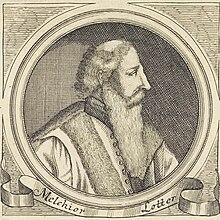Melchior Lotter the Elder
Melchior Lotter the Elder, also Lotther , (* 1470 in Aue ; † February 1, 1549 in Leipzig ) was a German printer and publisher .
life and work
Melchior Lotter the Elder Ä. learned at Konrad fireplace , one of the first printer Leipzig, the job of the printer ( the high pressure ) and was initially his assistant. He later married his daughter and received Leipzig citizenship in 1498 . Both printers traded together until around 1500, after which Lotter took over the office of his father-in-law Konrad Kachelofen. The first reliably verifiable print under Lotter's name dates from 1491. By the end of the 15th century, Lotter printed and published classic school and study texts as well as writings of a theological character that were typographically of particular quality in Latin. From 1500 onwards, works of early humanism were increasingly added. Around 1500 Leipzig was at the top of the German early printing locations with its 11 printing plants. University operations were an important client for the printing companies.
Lotter recognized the book production, which was growing at that time, adjusted to it in terms of production technology and became one of the most important printers ( letterpress ) in Leipzig from 1500 . He was also successful as a general-purpose bookseller until 1537 .
After meeting Martin Luther , he printed numerous of his Reformation writings after 1517, including the 95 theses . During the Leipzig disputation , he accepted the representatives of the Reformation in his house on Hainstrasse.
Lotter founded a branch in Wittenberg in 1519, the management of which he passed on to his sons Melchior and Michael . It was the second printing company there after Johann Rhau-Grunenberg's printing house in the Augustinian monastery. At the beginning of the 16th century, four printing works had been established in Leipzig: Wolfgang Stöckel , Jacob Thanner , Martin Landsberg and the Konrad Kachelofens office , which was taken over by Melchior Lotter around 1500. Lottersche printing had a slightly higher production rate than the other three printing craftsmen, of which Landsberg and Stöckel were roughly on par and Thanner had the lowest output.
literature
- Jakob Franck : Lotter, Melchior the Elder . In: Allgemeine Deutsche Biographie (ADB). Volume 19, Duncker & Humblot, Leipzig 1884, pp. 273-278.
- Hans Lülfing : Lotter, Melchior. In: New German Biography (NDB). Volume 15, Duncker & Humblot, Berlin 1987, ISBN 3-428-00196-6 , p. 246 f. ( Digitized version ).
- Thomas Thibault Döring: Leipzig book culture around 1500. Catalog for the exhibition of the same name in the Bibliotheca Albertina Leipzig from April 19 to July 22, 2012, Leipzig University Library 2012, ISBN 978-3-86583-675-5
- Stefan Oehmig (Ed.): Book printing and book culture in Wittenberg during the Reformation. Vol. 21, Writings of the Luther Memorials Foundation in Saxony-Anhalt, Evangelical Publishing House, Leipzig 2015, ISBN 978-3-374-04078-0 , excerpt [1]
- Enno Bünz (Ed.): Books, printers, libraries in Central Germany. New research on communication and media history around 1500. Leipziger Universitätsverlag, Leipzig 2006. ISBN 3-865-83120-6 . P. 88 and so on
Web links
- Prints by Melchior Lotter the Elder in the complete catalog of incandescent prints
- Works by and about Melchior Lotter the Elder in the German Digital Library
- Prints by Melchior Lotter d. Ä. in the catalog of the University and State Library Halle
- Prints by Melchior Lotter the Elder in the VD 16 catalog, when entering all fields - Lotter Leipzig
- ( Page no longer available , search in web archives )
- ( Page no longer available , search in web archives )
Individual evidence
- ↑ Berlin State Library: Complete Catalog of Wiegendrucke, No. M20696. Manuale parochialium sacerdotum. Retrieved on May 22, 2017 (German).
- ↑ Andrew Pettegree : The Luther brand. How an unknown monk made a small German town the center of the printing industry and himself the most famous man in Europe - and kicked off the Protestant Reformation. Insel, Berlin 2016, ISBN 978-3-458-17691-6 , p. 154
| personal data | |
|---|---|
| SURNAME | Lotter, Melchior the Elder |
| ALTERNATIVE NAMES | Melchior Lotther |
| BRIEF DESCRIPTION | German printer and publisher |
| DATE OF BIRTH | 1470 |
| PLACE OF BIRTH | Aue |
| DATE OF DEATH | February 1, 1549 |
| Place of death | Leipzig |

